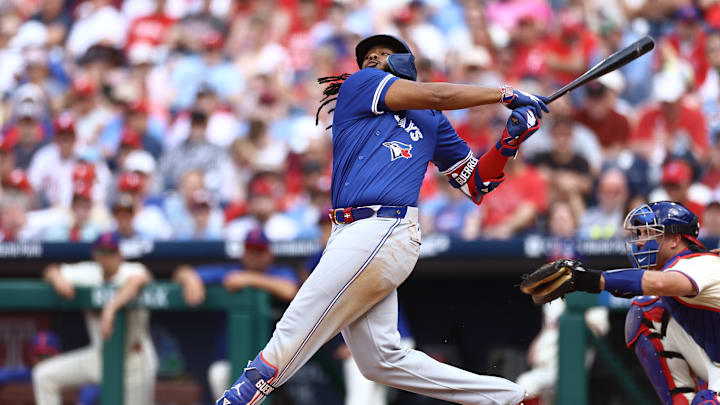For the 2024 MLB season, much has been talked about in regards to the struggling hitters and offense for the Toronto Blue Jays. As a result of it, many have been looking for explanations as to why such a talented team seemed lost at times at the plate.
With Statcast’s newly-released bat tracking data, we may have uncovered part of the answer to their troubles. So what this new statistical measure looks at involves everything from the speed of the bat, to combining it with part of the bat’s motion and sweet spot, leading to the eventual outcome.
There are a total of six new Statcast metrics to measure the bat tracking data: bat speed, fast-swing rate, squared-up rate, blasts, swing length and swords. We will provide a brief description of each, while a more in-depth explanation can be found in the informative piece formulated by Mike Petriello of MLB.com. For a more simplified definition of each metric, the glossary can be found here.
Bat speed is measured at the sweet spot of the bat when it connects to the ball. It takes into consideration the average of the top 90% of the batter’s swings to eliminate things such as check swings and bunts in terms of contact. The MLB average for this stat is 72 mph.
Fast-swing rate measures any swing that produces a bat speed of 75 mph or greater. On average about one-quarter of a ballplayer’s swing are ‘fast’ swings.
So for both of these cases, the faster the swing, the better the outcome (hypothetically).
For squared-up rate, this metric can help differentiate between just a pure power hitter versus a contact hitter with power. To ‘square-up’ to a ball and consider it a ‘squared-up’ swing, the swing has to attain at least 80% of the maximum attainable exit velocity based on the speed on the swing and pitch. In general, this can only happen on the bat’s sweet spot. So the more squared-up a batter is, the more success is likely to result.
A blast consists of a swing that is fast and squared-up at the same time. Usually with that combination, the results are quite dramatic, with almost a 400-point batting average difference between those producing blasts and those that fail to do so.
Swing length is the distance from the start of a swing until the point of impact with the ball. This usually varies between four to ten feet in length. But unlike the previous four metrics, the variation in length doesn't necessarily dictate good or bad, as it just reflects more on the style of the batter's swing instead.
Finally, swords are awkward, uncomfortable swing outcome that results from a nasty pitch. So for a hitter, they should try their best to avoid these, unless they want to make the highlight reels.
With that in mind, let’s take a look how some of these measures have affected the Blue Jays this year.
On the season, the Jays currently rank in the bottom five in the league in runs scored (150), hits (307), home runs (35) and the bottom third in the league in batting average (.231) and OPS (.670). Despite supposedly to be an offensive force led by the likes of George Springer, Vladimir Guerrero Jr., Bo Bichette and others, the one troubling area with this new statistical measure that stands out above the rest is the fact that the Jays currently rank dead last in bat speed at 70.1 mph. Recall that 72 mph is the league average, so the Jays are definitely performing below everyone else. On top of that, they only rank ahead of three teams in terms of fast-swing rate at 16.2%. It certainly isn’t reassuring to know that those three teams happen to be the Chicago White Sox, Cincinnati Reds and Washington Nationals, who also happen to be three of the worst offensive clubs in the league to date.
If it wasn't any worse, the Jays also rank 22nd in the league for square-up rate and once again dead last in blasts as a result. Perhaps the only positive aspect coming out from the measurements is the fact that collectively as a team, they have struck out only 299 times, ranking them in the top three of MLB. So by being more selective at the plate and not swinging hard and fast, at least they are not flailing at pitches. But at the same time, that disciplined plate approach may ultimately be the main culprit that has limited their offensive explosiveness all season.
Just for comparison, both the New York Yankees and Atlanta Braves have been performing well under these new statistical metrics, which is consequently reflected by their strong records and place in the MLB standings as a result. So having a fast bat with solid contact may not be everything, but it has certainly proved to be a successful winning formula for any team.
So perhaps the Jays should just start developing a more aggressive approach at the plate and focus on increasing the speeds of their swings, hopefully leading to better outcomes. The strikeouts will likely mount, but if can actually lead to more run production in the end, it may be the trade-off that’s worth taking for the Jays going forward. At least based on these new Statcast metrics, one can truly believe it can make a significant difference.
